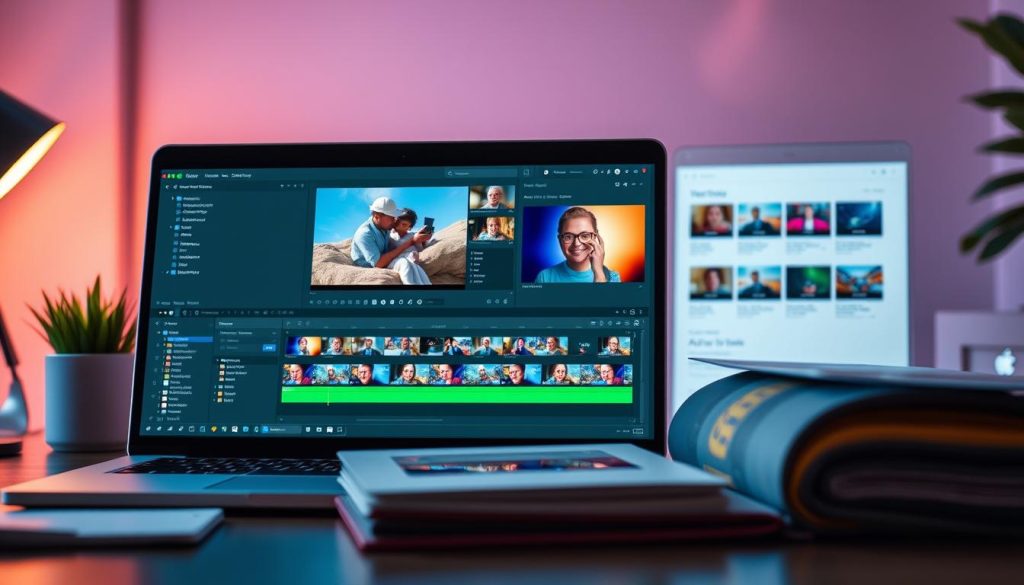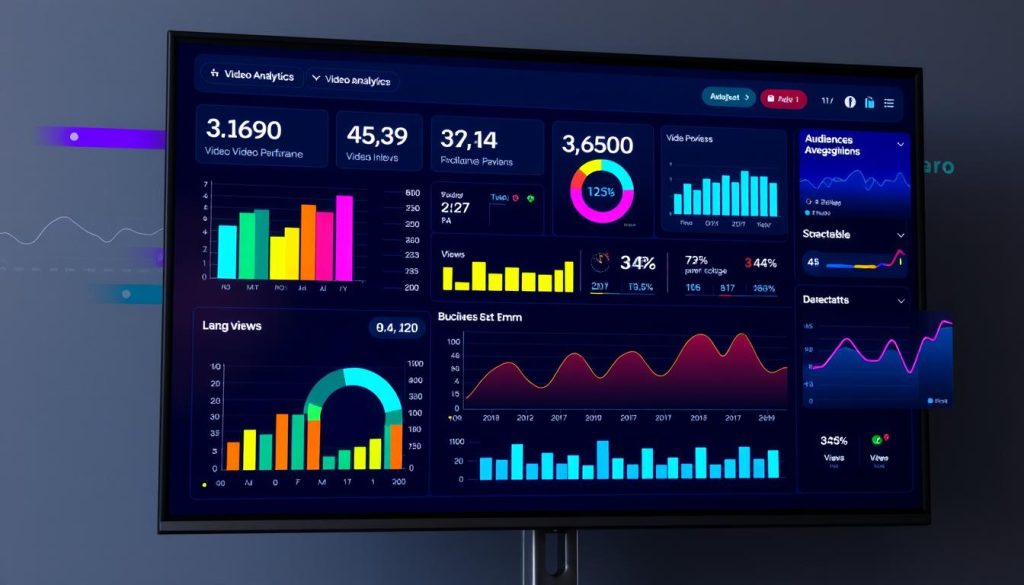In today’s digital landscape, video content reigns supreme. The surge in popularity of platforms like YouTube and TikTok has prompted businesses to explore video’s power in their content strategies. Yet, simply creating compelling videos is insufficient. They must also be optimised for search engines to effectively reach your target audience.
That’s where video SEO comes in. At LerriHost, we grasp the critical role of video optimisation in elevating search engine visibility. This guide will cover the fundamentals of video SEO, from technical necessities to content distribution tactics. Whether you’re an experienced marketer or just starting, you’ll uncover actionable tips to boost your video content’s performance.
Key Takeaways
- Video SEO is vital for increasing search engine visibility
- Optimisation techniques differ across various hosting platforms
- Technical aspects like file formats and loading speed are critical
- Engaging titles, descriptions, and thumbnails enhance click-through rates
- Transcripts and captions provide SEO advantages
- Monitoring performance is essential for refining your video SEO strategy
Understanding Video SEO Fundamentals
Video content optimisation is now vital in our digital world. Search engine algorithms focus more on video ranking factors. We’ll look into video SEO basics and how it differs from text optimisation.

What Makes Video Content Different from Text
Video content engages more senses than text. It uses visuals and sound to share information fast and well. Search engines check video metadata, transcripts, and user interaction to judge its worth.
Core Elements of Video Optimisation
Effective video optimisation includes several key points:
- Compelling titles and descriptions
- Relevant tags and categories
- High-quality thumbnails
- Accurate transcripts and closed captions
- Optimised video sitemaps
By focusing on these, you can greatly boost your video’s search visibility.
The Impact of Video on Search Rankings
Optimised videos can enhance your search rankings. They increase dwell time, improve user interaction, and offer valuable content. As video content’s popularity grows, mastering video SEO is key to staying ahead online.
Why Video SEO Matters in Today’s Digital Landscape
In the digital marketing world, video content has emerged as a key player in grabbing audience attention. Video SEO is vital for maximising the impact of this content. It drives user engagement and boosts brand visibility.
The rise of video marketing has changed how businesses interact with their audience. With YouTube processing over a billion hours of video daily, it’s evident that people love visual content. Optimising videos for search engines allows companies to reach a vast audience.

Properly optimised video content significantly increases user engagement. Viewers spend 88% more time on websites with videos, leading to better search rankings. This extended interaction offers brands a chance to share their message and build strong connections with their audience.
Effective video SEO also enhances brand visibility. Videos in search results often stand out, attracting more clicks. This increased visibility can lead to higher website traffic, better conversion rates, and stronger brand recognition.
“Video is the future of content marketing. It’s a powerful tool that allows brands to tell their story in a way that resonates with audiences.”
Strong video SEO strategies are now a must for staying competitive online. By adopting these strategies, businesses can fully utilise their video content. This drives growth and success in the digital world.
Essential Video Hosting Platforms for SEO Success
Choosing the right video hosting platforms is key to your SEO strategy. We’ll look at the top options and how to optimise them for better video content visibility.
YouTube Optimisation Strategies
YouTube, the second-largest search engine, is a goldmine for video SEO. To enhance your YouTube SEO:
- Craft compelling titles with relevant keywords
- Write detailed descriptions including timestamps
- Use tags strategically to improve discoverability
- Create eye-catching custom thumbnails

Vimeo Best Practices
Vimeo is perfect for professionals and businesses. For effective Vimeo optimisation:
- Choose appropriate categories and subcategories
- Add relevant tags to improve searchability
- Craft engaging video descriptions with links
- Utilise Vimeo’s SEO settings for each video
Self-Hosting Considerations
Self-hosting videos on your website gives you full control but has its challenges. Consider these factors:
| Pros | Cons |
|---|---|
| Full control over video player | Increased server load |
| No third-party branding | Higher bandwidth costs |
| Direct integration with website | Potential impact on page load speed |
| Custom analytics | Limited built-in sharing options |
Understanding the specifics of these platforms helps you make better choices. This way, you can boost your video SEO and reach more people.
Video SEO: Technical Requirements and Standards
Mastering video SEO demands a grasp of key technical elements that affect your content’s performance. We’ll dive into the essential aspects of video file optimisation, page load speed, and mobile-friendly videos.
Video File Formats and Compression
Opting for the right file format is critical for video file optimisation. MP4 is a top choice, balancing quality with file size effectively. WebM is also excellent for web-based videos. Techniques like H.264 or VP9 can greatly reduce file sizes without sacrificing quality.

Loading Speed Optimisation
Page load speed is essential for user experience and SEO. To enhance video loading times, consider adaptive bitrate streaming. This method adjusts video quality according to the viewer’s internet speed. A content delivery network (CDN) can also distribute your video, reducing load times globally.
Mobile Responsiveness
In today’s digital world, mobile-friendly video experiences are a must. Ensure your video player adjusts to various screen sizes. Use HTML5 players for cross-device compatibility. Offer lower-resolution versions for mobile users with limited data plans.
| Aspect | Best Practice | SEO Impact |
|---|---|---|
| File Format | MP4 or WebM | Improved load times, better crawlability |
| Compression | H.264 or VP9 | Faster loading, reduced bounce rates |
| Streaming | Adaptive bitrate | Enhanced user experience, longer view times |
| Mobile Design | Responsive player | Improved mobile rankings, higher engagement |
By concentrating on these technical elements, you lay a strong foundation for your video SEO strategy. This ensures your content excels on all devices and search engines.
Crafting Engaging Video Titles and Descriptions

Creating compelling video titles and descriptions is key to boosting your content’s visibility and click-through rate. By mastering the art of video metadata, you can significantly improve your search rankings and attract more viewers.
When crafting titles, focus on keyword optimisation without sacrificing readability. Aim for a balance between search-friendly terms and eye-catching phrases that pique curiosity. Keep titles concise, ideally under 60 characters, to ensure they display fully in search results.
For descriptions, start with a strong hook that summarises your video’s content. Incorporate relevant keywords naturally throughout the text, but avoid keyword stuffing. Include a clear call-to-action and any necessary links or timestamps.
“A well-crafted title and description can make the difference between a viewer clicking or scrolling past your video.”
Consider these tips for optimising your video metadata:
- Use power words to evoke emotion and curiosity
- Include numbers or statistics to add credibility
- Pose questions that your video answers
- Experiment with different formats and analyse performance
| Element | Best Practice | Impact on SEO |
|---|---|---|
| Title | Use main keyword, keep under 60 characters | Improves search visibility |
| Description | Include keyword variations, 150-300 words | Enhances relevance signals |
| Tags | Use 5-8 relevant tags | Helps categorisation |
By implementing these strategies, you’ll create video metadata that appeals to both search engines and viewers. This will drive higher click-through rates and engagement.
Optimising Video Thumbnails for Higher Click-Through Rates
Optimising video thumbnails is key to boosting click-through rates and visual appeal. A well-designed thumbnail acts as a mini-billboard, enticing viewers to click and watch. Let’s explore effective strategies for creating eye-catching thumbnails that drive engagement.
Thumbnail Design Best Practices
When designing thumbnails, focus on clarity and relevance. Use high-contrast colours, bold text, and engaging imagery that accurately represents your video content. Avoid cluttered designs and ensure your thumbnail looks great on both desktop and mobile devices.
- Use high-quality, clear images
- Include faces or close-ups for human connection
- Utilise contrasting colours for text visibility
- Keep text concise and legible

A/B Testing Thumbnails
To maximise click-through rates, conduct A/B tests with different thumbnail designs. Create multiple versions and track their performance to identify which ones resonate best with your audience. This data-driven approach helps refine your thumbnail strategy over time.
Custom Thumbnail Creation Tools
Several tools can help you create visually appealing thumbnails:
| Tool | Features | Skill Level |
|---|---|---|
| Canva | Templates, drag-and-drop interface | Beginner |
| Adobe Spark | Professional design tools, stock images | Intermediate |
| Photoshop | Advanced editing, complete customisation | Expert |
By implementing these video thumbnail optimisation techniques, you can significantly improve your click-through rates and overall visual appeal. This leads to increased viewer engagement and better search rankings.
Video Transcripts and Closed Captions: The SEO Benefits
Video transcripts and closed captions are key for boosting your content’s SEO. They enhance video accessibility and significantly improve content indexing and user experience.
Transcripts give search engines text to crawl and index, boosting your video’s visibility in search results. This text-based content helps search engines understand and categorise your video more effectively.

Closed captions offer many benefits for user experience. They allow viewers to enjoy your content in sound-sensitive environments or with hearing impairments. This inclusivity can increase watch time and engagement, which are good signals for search engines.
Creating accurate transcripts and captions can be manual or automated. Manual transcription ensures high accuracy but is time-consuming. Automated tools provide a quicker option but may need editing for the best results.
| Feature | SEO Benefit | User Experience Benefit |
|---|---|---|
| Video Transcripts | Improved content indexing | Accessibility for all users |
| Closed Captions | Increased watch time | Better comprehension in various environments |
Incorporating transcripts and captions optimises for search engines and enhances the viewing experience. This dual benefit makes them vital for any video SEO strategy.
Implementing Video Sitemaps and Structured Data
Optimising videos for search engines requires more than just creating engaging content. It demands technical measures to make your videos discoverable. Let’s dive into the process of setting up video sitemaps and structured data to enhance your SEO.
Schema Markup for Videos
Video schema markup is a key tool for sharing video details with search engines. It translates your video content into a language search engines can understand. This increases the likelihood of rich snippets appearing in search results.

Creating Video Sitemaps
XML sitemaps serve as a guide for search engine crawlers. A video sitemap, in particular, highlights your video content. It provides essential information like video title, description, and duration. This helps search engines index your videos more efficiently.
Implementation Guidelines
Here are the steps to implement video sitemaps and structured data:
- Use consistent information across your schema markup and video sitemap
- Ensure your video URLs are accessible to search engine crawling
- Update your sitemaps regularly as you add new video content
- Submit your video sitemap to search engines through their webmaster tools
By adhering to these technical SEO practices, you’re giving your videos the best opportunity to stand out in search results. This will drive more traffic to your content.
Video Content Distribution and Embedding Strategies
Ensuring your video content reaches the right audience is key to its success. A strategic distribution plan can significantly enhance its visibility and engagement. Let’s dive into effective methods for broadening your video’s reach.

Content syndication is a potent tool for increasing your video’s exposure. By collaborating with relevant sites or platforms, you tap into new viewers. This not only boosts views but also fosters valuable backlinks to your site, strengthening your content marketing strategy.
Social media sharing is indispensable for any video distribution strategy. Each platform presents unique opportunities to connect with viewers:
- Facebook: Ideal for longer videos and live streaming
- Instagram: Perfect for short, visually engaging clips
- Twitter: Great for brief teasers or announcements
- LinkedIn: Suited for professional and educational content
Website embedding is vital for driving traffic to your site. Hosting videos on your pages keeps visitors engaged, improving your SEO rankings. Ensure your embedding code is optimised for fast loading and mobile friendliness.
| Distribution Method | Pros | Cons |
|---|---|---|
| Content Syndication | Wider reach, backlink building | Less control over presentation |
| Social Media Sharing | High engagement, targeted audience | Platform-specific limitations |
| Website Embedding | SEO benefits, visitor retention | Potential impact on page load speed |
By integrating these strategies, you can establish a robust distribution network for your video content. This ensures it effectively reaches and resonates with your target audience across various channels.
Measuring Video SEO Performance
To boost your video content’s visibility, tracking its performance is key. By analysing key metrics, you can refine your strategy for better results. Let’s explore how to measure your video SEO success effectively.
Key Performance Indicators
Understanding the right KPIs is vital for video SEO. These indicators help gauge your content’s impact:
- View count
- Watch time
- Engagement rate
- Click-through rate (CTR)
- Subscriber growth
Analytics Tools and Metrics
Various tools offer insights into your video performance. Platform-specific analytics like YouTube Analytics provide valuable data. Third-party tools can offer more detailed tracking across multiple platforms.
| Tool | Key Features | Best For |
|---|---|---|
| YouTube Analytics | Audience demographics, traffic sources | YouTube-specific insights |
| Google Analytics | Website integration, conversion tracking | Overall website performance |
| Vidyard | Viewer engagement, lead scoring | B2B video marketing |
Tracking User Engagement
User engagement is a critical aspect of video analytics. It reveals how viewers interact with your content, helping you refine your strategy. Key engagement metrics include:
- Comments and likes
- Shares
- Average view duration
- Audience retention
By consistently monitoring these performance metrics and using video analytics tools, you can make data-driven decisions to enhance your video SEO strategy. Remember, engagement tracking goes beyond numbers. It’s about understanding your audience and creating content that resonates with them.

Common Video SEO Mistakes to Avoid
Video SEO is a powerful tool, but it’s easy to stumble into SEO pitfalls. Let’s explore some common optimisation errors and best practices to keep your video content on track.

One frequent mistake is keyword stuffing. While it’s essential to include relevant keywords, overusing them can harm your rankings. Instead, focus on creating natural, engaging descriptions that accurately reflect your video’s content.
Neglecting mobile optimisation is another critical error. With the rise of mobile viewing, ensuring your videos are responsive across all devices is essential. Test your content on various screen sizes to guarantee a smooth user experience.
Many creators overlook the importance of unique thumbnails. Generic or low-quality thumbnails can significantly reduce click-through rates. Invest time in crafting eye-catching, relevant thumbnails for each video to boost engagement.
- Ignoring video transcripts and captions
- Failing to optimise video length for audience retention
- Neglecting to update old video content
Remember, staying informed about algorithm changes is critical. Search engines constantly evolve, and what worked yesterday might not work today. Regularly review and adjust your video SEO strategy to stay ahead of the curve.
“Learning from mistakes is the key to mastering video SEO. Embrace the process and keep refining your approach.”
By avoiding these common pitfalls and implementing best practices, you’ll be well on your way to maximising your video content’s visibility and engagement.
Advanced Video SEO Techniques by LerriHost
LerriHost is at the forefront of advanced video SEO techniques, expanding the limits of search engine optimisation. These innovative strategies can greatly enhance your video content’s visibility and performance in search results.
Video Rich Snippets
Video rich snippets are a transformative element in SERP features. They showcase thumbnail images alongside video titles and descriptions, making your content more prominent. LerriHost optimises video metadata and uses structured data to boost the chances of Google displaying these compelling snippets.

Video Featured Snippets
Featured snippets for videos are highly sought-after in search results. LerriHost’s strategy involves creating concise, informative video content that directly answers common queries. By structuring your video descriptions and transcripts effectively, you increase your chances of securing these coveted positions.
Video Position Zero Strategies
Achieving ‘Position Zero’ for videos is the pinnacle of video SEO. LerriHost’s techniques include:
- Optimising video titles with clear, question-based formats
- Creating detailed video descriptions that summarise key points
- Using timestamps to highlight important sections of your video
By adopting these advanced techniques, you’ll be well-positioned to dominate video search results and drive more traffic to your content.
Future Trends in Video SEO
The world of video SEO is changing fast, thanks to new technologies. These innovations are altering how we make, improve, and find video content. Looking ahead, several trends are set to change the game.

AI in video will be key in making and optimising content. Machine learning will study how viewers act, helping creators make more engaging videos. It will also help make better video transcripts and translations, reaching more people worldwide.
Voice search optimisation is becoming vital for finding videos. With more smart speakers and voice-activated devices, making videos easy to find with voice commands is essential. Creators will need to use conversational keywords and long-tail phrases in titles and descriptions.
Immersive video experiences are coming, with virtual and augmented reality. These new formats will bring new challenges and chances for SEO. They will need new ways to handle metadata and indexing.
| Trend | Impact on Video SEO | Adaptation Strategy |
|---|---|---|
| AI in video | Enhanced content optimisation | Integrate AI tools for analytics and content creation |
| Voice search optimisation | Shift in keyword strategy | Optimise for natural language and long-tail queries |
| Immersive video formats | New indexing challenges | Develop VR/AR-specific metadata strategies |
As these trends emerge, being flexible and embracing new tech is vital for staying ahead in video SEO. The future looks bright for those willing to try new tools and strategies.
Conclusion
Video SEO is transforming the digital world. A well-planned video marketing strategy can significantly enhance your online presence and engage your audience deeply. Optimising titles, descriptions, and using video sitemaps are key steps to boost your content’s visibility.
SEO for videos is an ongoing process. It demands continuous optimisation to keep pace with search engine updates. Begin with quality content, and then expand your efforts to see real improvements in your video’s performance.
LerriHost is committed to aiding your video SEO journey. Our team of experts will guide you through the complexities of video optimisation. By applying the strategies from this guide and staying current with industry trends, you’ll master Video SEO. This will help you achieve your digital marketing objectives.
